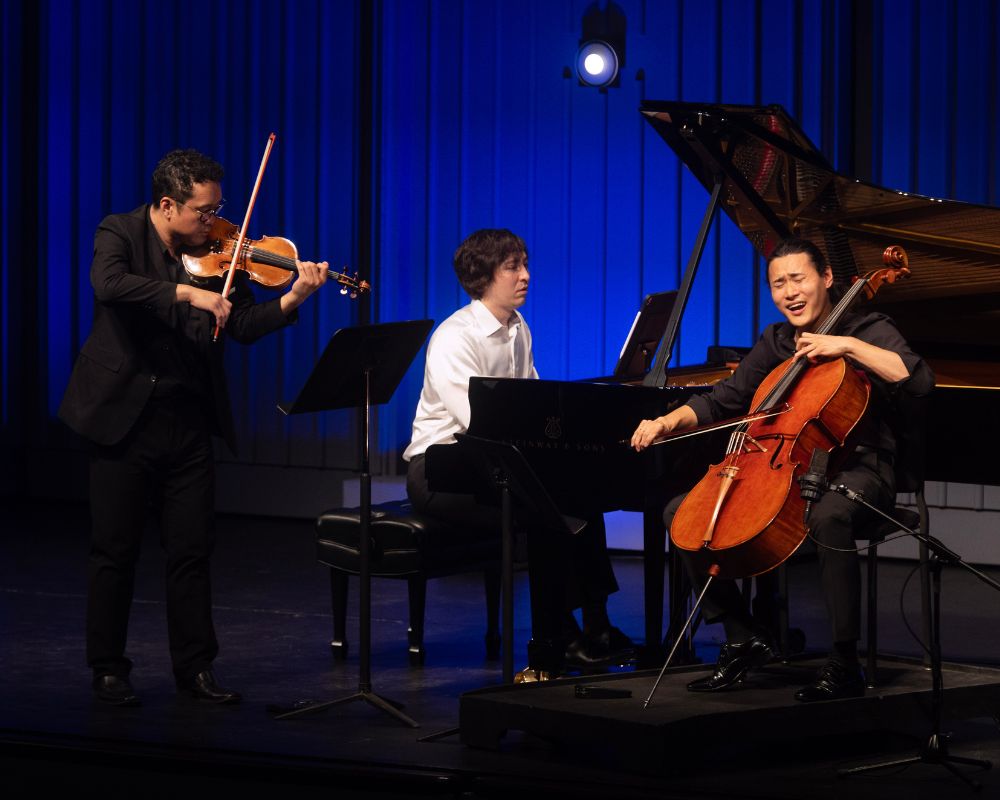
Trio Barclay
Arensky and Seyfried
Sunday, May 18, 2025 at 5pm
Trio Barclay is Sponsored by
Eugene and Carol Choi
Mike and Ellie Gordon
Terry and Judy Jones
Karen Kuo-Limb and Jong C. Limb
Goran Matijasevic
Dot and Rick Nelson
Bob Romney
Richard and Cheryll Ruszat
Joel and Judy Slutzky in Honor of Ellie Gordon
Al Spector and Tatjana Soli
Ken & Sandy Tokita
Wes and Judy Whitmore
Charlie and Ling Zhang
This performance will include a 15-minute intermission.
Dennis Kim: Violin
Jonah Kim: Cello
Sean Kennard: Piano
ANTON ARENSKY: PIANO TRIO NO. 1 IN D MINOR, OP. 32 (1894)
I. ALLEGRO MODERATO
II. SCHERZO. ALLEGRO MOLTO
III. ELEGIA. ADAGIO
IV. FINALE. ALLEGRO NON TROPPO
-INTERMISSION-
SHERIDAN SEYFRIED: PIANO TRIO NO. 3 (2025)
I. SLOW AND EXPRESSIVE - DRIVEN AND LIVELY
II. LAID - BACK WITH A GROOVE
III. HEARTFELT AND TENDER
IV. SONGLIKE AND SPIRITED
Anton Arensky’s Piano Trio No. 1 stands as one of his most celebrated works, composed in 1894 and dedicated to the memory of the revered Russian cellist Karl Davydov. A student of Rimsky-Korsakov and later a teacher of Rachmaninoff and Scriabin, Arensky is often noted for his lyrical gift and his refined sense of texture, both of which are on full display in this emotionally rich trio.
The work opens with a dramatic Allegro moderato, where sweeping melodies and urgent rhythms immediately establish the piece's Romantic character. The dialogue between piano, violin, and cello is deeply expressive, with each voice given equal weight. The second movement, a Scherzo, is lively and graceful, featuring playful cross-rhythms and a contrasting lyrical trio section.
The heart of the trio lies in the Elegia, a deeply moving lament imbued with a sense of reverence, likely reflecting Arensky's tribute to Davydov. The cello, fittingly, plays a prominent role here, singing with soulful poignancy. The finale, Allegro non troppo, recalls themes from earlier movements, bringing the trio full circle with a sense of cohesion and resolution.
Though Arensky's life was short, his Piano Trio No. 1 has endured as a cornerstone of the Romantic chamber repertoire, admired for its melodic richness, emotional depth, and finely crafted interplay among instruments.
As a resident of Pennsylvania myself, the Irvine Barclay Theatre is starting to feel like a home away from home. I've written music for many of Trio Barclay's performances there, starting with their very first in June of 2021. As Sean, Dennis, and Jonah are long-time friends of mine, I feel especially inspired to write my best music for them, and the chance to share that music with the Irvine audience we've all come to know and love is a distinct pleasure.
In this new piece for piano trio (my third in the form), I've aspired to write music of a direct quality that communicates easily. Written in four movements, the piece takes the listener on an emotional journey. The first movement begins with a slow introduction, which gives a foretaste of some of the moods to be felt later in the piece. The body of the movement has a dark-hued, driven quality, occasionally foreshadowing something more hopeful. The movement thus raises questions that will be answered later in the work.
The second movement, in the tradition of a scherzo (in Beethoven's time, a more light-hearted or jesting movement), gives the listener a brief escape from the drama of the work as a whole and offers the impression of rhythmic, angular dancing, at times settling into an almost contagious groove. The third movement is a slow, heartfelt song - and is indeed the heart of the work. I often find that much of what's most important, or most honest, seems to find its expression in slow movements. By the end of the movement, there is a feeling that a process has been completed - something has been resolved. And so, we embark on a celebration: a dancing, singing finale (the fourth movement). Still some drama remains (there are questions yet to be answered) but there is little doubt that the conclusion will be one of joyous transcendence.
Program note by Sheridan Seyfried